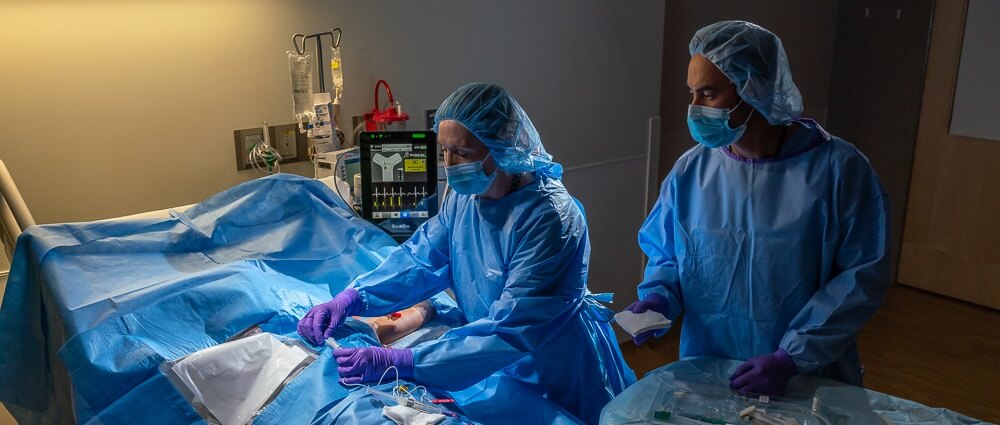The state of vascular access teams: Results of a European survey
Scientific publication on Vascular Access Teams: Cortés Rey N, Pinelli F, van Loon FHJ, et.al, Int J Clin Pract. 2021 Sep 13:e14849. doi: 10.1111/ijcp.14849.
Introduction
Vascular access devices are widely used for the safe administration of medication, electrolytes, fluids, parenteral nutrition and blood products.1 In hospitals, 60 – 90 % of the admitted patients receive an intravenous (IV) device during their stay.2 Vascular access teams (VATs) are specifically trained groups of healthcare professionals who assess, place, manage and monitor various outcomes and aspects of vascular access care.1 Many European health institutions have appointed multidisciplinary VATs to help improve efficiency, patient safety and reduce costs.1
The survey
There are, at present, no Europe-wide guidelines for the comprehensive management of vascular access devices (VAD). Also, the current landscape of vascular access management as a discipline across Europe is relatively unknown.1 To remedy this, a faculty of multidisciplinary European VAT leads and experts developed a survey. As the goal was also to identify and prioritise areas of further focus, the following topics were addressed:
- What types of vascular access devices were being used and how does this vary between institutes and countries?
- Who is placing the devices?
- What are the difficulties individuals encounter when carrying out vascular access management and who/where do they go for help?
- What complications are being monitored and reported?
The survey was disseminated in six languages and two rounds through professional networks and general health societies. Round 1 was through peer dissemination in February and March 2020. Round 2 was via the Hospital Healthcare Europe (HHE) database in July and September 2020. There were a total of 1449 respondents primarily from France, Germany, Italy, Spain, the UK, Ireland and the Netherlands. The respondents were nurses, physicians, surgeons, radiologists and anaesthetists from public hospitals and private institutions of varying sizes.
The results
The survey revealed that the availability of dedicated vascular access teams varies by country, institution size and type. Smaller institutions are more likely not to have a vascular access team, but increasingly, larger institutions are more likely to have one. Public, non-teaching hospitals have a significantly higher presence of VATs compared with private hospitals and clinics.
Institutions with vascular access teams are more likely to use a tool (eg. algorithm or guideline) to determine the appropriate vascular access devices, and the type of tool used varies slightly with the presence of a VAT. Midlines and arterial catheters appear to be more common at institutions that use a tool. Institutions with a VAT are more likely to place devices such as midlines and peripherally-inserted central catheters (PICCs) than those without.1
Institutions with a vascular access team were also more likely to systematically monitor complications than the ones without, and their respondents were more likely to have received training on vascular access management, incl. placement, care and maintenance. In addition, respondents from institutions with a VAT had additional support and relative awareness of vascular access policies.
The results of the survey, therefore, highlighted some potential benefits of a dedicated VAT. These include a broader range of VADs, increased awareness of vascular access policies, increased rate of complication monitoring and a greater likelihood of vascular access training.1
The survey also helped identify and prioritise areas for further focus and more robust scientific study. These included country-specific implementation of VATs, the impact of tools in decision making and awareness and improving education and training. There is also a need for more scientific evidence on the impact of VATs on clinical and economic outcomes.
References
1 Cortés Rey N, Pinelli F, van Loon FHJ, et.al The state of vascular access teams: Results of a European survey. Int J Clin Pract. 2021 Sep 13:e14849. doi: 10.1111/ijcp.14849.
2 Helm RE, Klausner JD, Klemperer JD, et.al . Accepted but unacceptable: peripheral IV catheter failure. J Infus Nurs. 2015 May-Jun;38(3):189-203. doi: 10.1097/NAN.0000000000000100. PMID: 25871866.
The references to third-party peer-reviewed material and the sites they are hosted on are provided for your reference and convenience only, and do not imply any review or endorsement of the material or any association with their operators. The Third-Party References (and the websites to which they link) may contain information that is inaccurate, incomplete, or outdated. Your access and use of the Third Party Sites (and any websites to which they link) is solely at your own risk.
Approval number BD-50365




